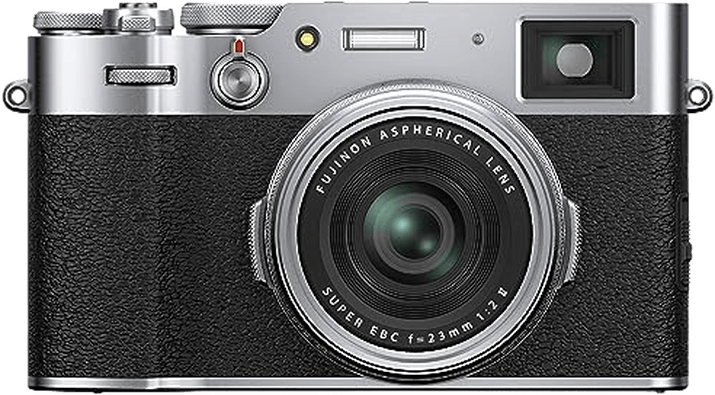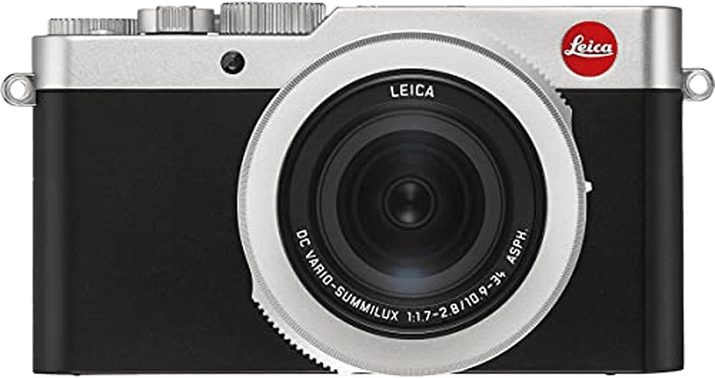Fujifilm X100V vs Leica D-Lux 7 Comparison
Fujifilm X100V

Leica D-Lux 7

The Fujifilm X100V outperforms the Leica D-Lux 7 with a score of 69/100 compared to 60/100. Both cameras share similarities, such as being released in the past few years (X100V in 2020 and D-Lux 7 in 2018) and having relatively high launch prices ($1399 for X100V and $1200 for D-Lux 7).
The X100V excels with its mirrorless camera type, offering better image quality and performance. Additionally, it’s slightly larger at 128 x 75 x 53mm and weighs 478g, providing a more robust feel. On the other hand, the D-Lux 7 is a compact camera with a smaller size of 118 x 66 x 64mm and lighter weight of 403g, making it more portable.
In the end, the Fujifilm X100V is the superior choice for those seeking better performance, while the Leica D-Lux 7 is better suited for users valuing portability.
Fujifilm X100V vs Leica D-Lux 7 Overview and Optics
The Fujifilm X100V emerges as the winner in our optics comparison, scoring 66/100, while the Leica D-Lux 7 trails behind with a score of 59/100. Both cameras share several common specifications, such as an 11 fps shooting speed, CMOS sensor type, and a fixed lens mount, which means neither camera allows for lens changes.
The Fujifilm X100V outperforms the Leica D-Lux 7 in several aspects. It has a higher megapixel count at 26, compared to the Leica’s 17, allowing for more detailed images. Additionally, the X100V has a larger APS-C sensor size, which typically results in better image quality and low-light performance. The camera also features the X-Processor 4, providing faster image processing and improved performance.
On the other hand, the Leica D-Lux 7 has some advantages as well. Its DXOMARK sensor score of 72 indicates a reliable sensor performance. Furthermore, the Leica camera offers image stabilization, a feature lacking in the Fujifilm X100V. This can be particularly useful when shooting in low-light conditions or with slower shutter speeds, as it helps reduce the impact of camera shake.
Considering the differences between the two cameras, the Fujifilm X100V is the stronger contender in terms of optics, thanks to its higher megapixel count, larger sensor size, and advanced processor. However, the Leica D-Lux 7 should not be disregarded, as its image stabilization and DXOMARK score make it a viable option for certain shooting situations. Ultimately, the choice between the two cameras will depend on the specific needs and preferences of the photographer.
Fujifilm X100V vs Leica D-Lux 7 Video Performance
The Fujifilm X100V outperforms the Leica D-Lux 7 in video capabilities with a score of 91/100, while the Leica D-Lux 7 scores 83/100. Both cameras share some common specifications, such as 4K maximum video resolution and built-in time-lapse functionality. However, the Fujifilm X100V surpasses the Leica D-Lux 7 in several aspects.
The Fujifilm X100V offers higher maximum video dimensions at 4096 x 2160, compared to the Leica D-Lux 7’s 3840 x 2160. This difference allows the X100V to capture more detailed and sharper footage. Additionally, the Fujifilm X100V provides a higher maximum video frame rate of 120fps, doubling the Leica D-Lux 7’s 60fps. This higher frame rate enables smoother slow-motion videos and more flexibility in post-processing.
On the other hand, the Leica D-Lux 7 does not have any significant advantages over the Fujifilm X100V in terms of video capabilities. Both cameras share the same 4K resolution and time-lapse functionality, but the Leica D-Lux 7 falls short in maximum video dimensions and frame rate.
Taking all factors into account, the Fujifilm X100V proves to be the superior camera for video capabilities due to its higher maximum video dimensions and frame rate. The Leica D-Lux 7, while still a good camera for video, does not offer any additional advantages in this area. Therefore, for users prioritizing video performance, the Fujifilm X100V is the recommended choice.
Fujifilm X100V vs Leica D-Lux 7 Features and Benefits
The Fujifilm X100V wins the features comparison with a score of 85/100, while the Leica D-Lux 7 scores 70/100. Both cameras share several specifications, including a 3-inch touchscreen, GPS absence, and connectivity options like WIFI and Bluetooth.
The X100V outshines the D-Lux 7 with its higher screen resolution of 1,620,000 dots, compared to the D-Lux 7’s 1,240,000 dots. This difference ensures a clearer and sharper display on the X100V. Additionally, the X100V has a flip screen, which the D-Lux 7 lacks. This feature allows for more flexibility in shooting angles and aids in capturing unique perspectives.
On the other hand, the Leica D-Lux 7 does not surpass the Fujifilm X100V in any specific feature. However, it matches the X100V in certain aspects, such as screen size, touchscreen capability, and connectivity options. The D-Lux 7’s lower score does not indicate any significant advantages over the X100V in terms of features.
After examining their features, it is evident that the Fujifilm X100V is the superior camera. Its higher screen resolution and flip screen provide users with a better experience and enhanced flexibility. While the Leica D-Lux 7 matches the X100V in some aspects, it does not offer any advantages that make it a better choice. Therefore, the Fujifilm X100V is the more reliable option for photographers seeking advanced features in their cameras.
Fujifilm X100V vs Leica D-Lux 7 Storage and Battery
The Fujifilm X100V wins the storage and battery comparison with a score of 37/100, while the Leica D-Lux 7 scores 35/100. Both cameras have one memory card slot and accept SD, SDHC, and SDXC (UHS-I compatible) memory cards. They also both offer USB charging.
The Fujifilm X100V outperforms the Leica D-Lux 7 in battery life, providing 420 shots per charge compared to 340 shots from the Leica. This advantage is due to the Fujifilm’s NP-W126S battery, which is more efficient than the Leica’s DP-DC15 battery.
However, the Leica D-Lux 7 does not have any notable advantages in storage and battery over the Fujifilm X100V. The two-point difference in scores reflects the Fujifilm X100V’s superior battery life, making it a better choice for photographers who require longer shooting sessions without the need to swap batteries or recharge frequently.
Fujifilm X100V vs Leica D-Lux 7 – Our Verdict
Are you still undecided about which camera is right for you? Have a look at these popular comparisons that feature the Fujifilm X100V or the Leica D-Lux 7:

